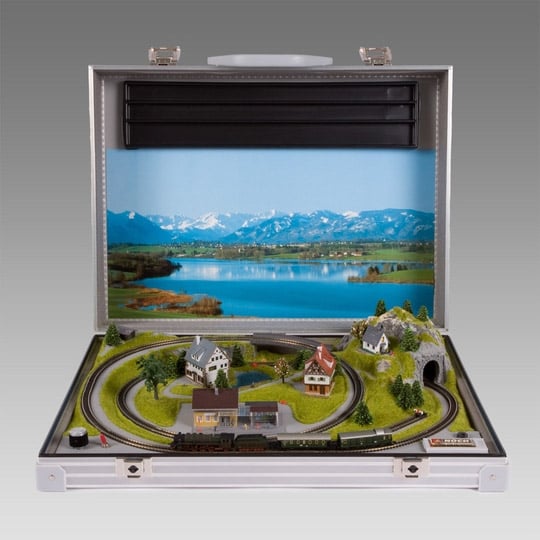 |
| Mini Train in a Brief Case |
I worked very briefly in a train museum in my misspent youth, located in a city which literally would not have happened had the choice for the lines been made a mere 50 miles south - as evidenced by the little town 50 miles south that didn't get the lines, which just eventually faded from a thriving community into ghost receivership, being revived as a small tourist attraction, all for the want of a train. I remember from my brief job at the museum just how in love the old railway men were with trains, delighting in running down corridors they technically shouldn't have been down, ducking under taped off areas with the staff in hot pursuit lest the villain who was our boss caught us both in forbidden areas. They used to tell us great stories of their adventures, some of them very gory and not something you would repeat, but because we were keeping the memory of their beloved trains, we were somehow part of the railway family and they felt very comfortable in sharing the family stories. Sadly I grew to loathe the job (due to the aforementioned villainous boss) by the end of the summer, but trains will always take a special place in my heart, and if it weren't for finances and space, I would have a railway of my very own in a shot.
Imagine my delight, then, when member Rosemary announced that we would be doing a two part O scale railway, complete with train layout, buildings and a little train! Sometimes things just work out. This train, of course, isn't a working model, but it is devishly adorable nonetheless. This appeared in an old Dollhouse Collector, I believe, and is a 1:12 scale 0 Scale railway printie. There were buildings, a station, miles of track, and a layout overlay (to be done at a later time).
 | |
| Printie Page Lionel O scale train |
 |
| Barb (l) and Margaret (r). examining their kits |
 |
| Block of Stores |
 |
| Block of Stores, 2nd image |
 |
| The Gang, Studiously Workin' On The Railroad, All the Live Long Day |
 |
| Block of Stores, plus the Controller Tower |
 |
| The Station House |
 |
| Station House |
In other news, of course when you have a meeting, you have to share what you have been doing. Well, okay, you don't "have" to, but it is nice, you know?
 |
| Member Sherril's Wine Tasting Diorama 1/4 scale |
 |
| Teeny Table!! |
 |
| Tiny Garden and Tiny House! 1/4 scale |
 |
| Inside the Little House |
 |
| Elizabeth's 1/12 scale Dog |
And that is a wrap for our meeting today. Hope you enjoyed the little window into our get together! To finish off, a few little pictures of some of the smallest trains you will ever see, darling as anything. Until next time, my little railroaders!
 |
| Tiny Train in an Eyeglasses Case! |
Above, 1:900 scale train - and it works!
Eyeglasses case train - pull tab locomotion.































